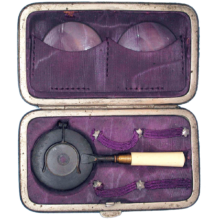This is a “non-luminous ophthalmoscope derived from the Loring style of ophthalmoscope. There are two overlapping lens wheels. The main one has larger lenses. Their powers are minus 1 to minus 9 D . The smaller lens has minus 10, 20 and 50 D and plus 10 and 20 D.
There is a rectangular plano mirror with a central opening. It can be rotated into position on the left or right side.
Max Burchardt (1831-1897)
Burchardt was born in Pomerania (an area between Poland and Germany on the Baltic Sea) in 1831. In 1851 he began his studies at the Friedrich-Wilhelms-Institut, a military-medical school in Berlin. He got his doctorate in 1855 and passed the state exam in 1857. Over the following years he was a unit medical officer until he was stationed in Berlin as the captain of the medical corps at Charite.
In 1864 he began work as a docent at the University of Berlin and he stayed there until 1866. After the Franco-Prussian war, he worked as a military doctor and directing physician in the ophthalmology department in Berlin. In 1890 he was made a professor and retired from the military as a brigadier general in 1896. He died of “lung inflammation” in 1897.
Burchardt published works on examination by the ophthalmoscope, vision testing, treatment of infectious conjunctivitis and other topics.
The purpose of his ophthalmoscope in 1883 was to give an continuous series of corrective lenses. This was a more convenient and natural progression that was that of other instruments of the time.
The lenses are on two discs with separate centers of rotation. The lower larger disc has number in steps of one unit. The upper disc has steps of ten. There are 9 concave lenses in the main disc from minus 1 to minus 9 diopters.
Their diameter is 8.5 mm. The disc is 40 mm in diameter. The combination disc has 5 lenses 10 mm in diameter. They are minus 0.5, minus 10 and minus 20 diopters. And plus 10 and plus 20 diopters.
Museum, Ophthalmoscopes







